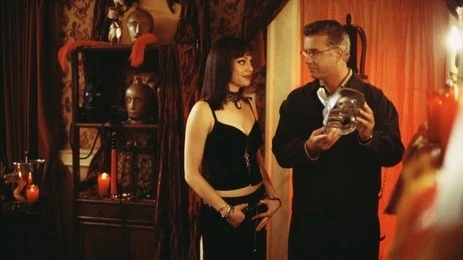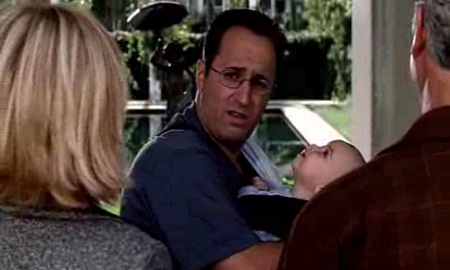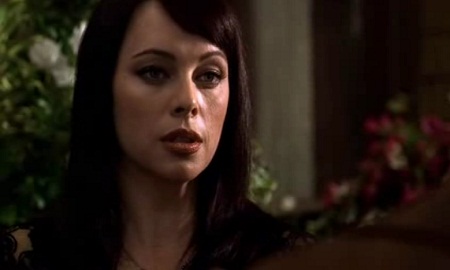IMDB Aired November 15, 2001.

Co-writer Jerry Stahl also wrote the notorious CSI episodes “Fur and Loathing in Las Vegas” (2003) (dealing with furry culture) and “King Baby” (2005) (dealing with infantilism). He also co-wrote the screenplays for the cult porn films Nightdreams (1981) and Café Flesh (1982), under the pseudonym Herbert W. Day.
Melinda Clarke makes her first appearance as Lady Heather. She also played a brothel madam in the Firefly episode “Heart of Gold” (2003) and the body-modified zombie lead of Return of the Living Dead 3 (1993).
As so many of these types of episodes, it begins with the discovery of a dead sex worker. In this case, it’s a nude young woman found buried in a sandbox. Also typical, the victim’s body is treated as a puzzle to be solved that will lead to the discovery of their true identity.
Grissom’s solo examination of the deceased’s nude body is shot and scored like a love scene, to Sigur Ros’ “Svefn-G-Englar”.
ME: “Her body’s a road map of abuse, but there’s no sign it was sexual. She hasn’t had intercourse in months.”
Willows: “I’m thinking trade-in. Some lowlife was tired of beating on the old model, so he punches her ticket and starts shopping around for version 2.0.”
Grissom: “Here’s a woman who’s been beaten on a regular basis, but look at the care she’s lavished on herself. Manicured fingernails, manicured toenails. Perfect teeth, hair.”
The victim’s breast implants lead them to a doctor, who leads them to an address in an old house, ruled by Lady Heather (the character’s first appearance in the series, played by Melinda Clarke).
Lady Heather: “Let me guess. Three police officers looking for respite from having to control and dominate our big bad city.”
She allows them in, without asking about warrants or probable cause or calling her lawyer. There are plenty of real-world cases of police harassing pro-dommes. Heather’s willingness to cooperate with the police puts making her sympathetic to the viewer over realistic concern about the privacy of Lady Heather, her employees or her clients.
The police officers explain this is business, not pleasure, and inform her of Mona’s death.
Lady Heather: “Never lost one of my girls.”
Grissom: “You don’t seem very upset about it.”
Lady Heather: “What you see and what I feel are two different things.”
[…]
Lady Heather: “It’s when I don’t hear screams that I start to worry.”
Grissom meets with Heather in her office. While speaking with her, he barely looks at her, and instead closely examines objects around her room, sometimes even picking them up. This is established as Grissom’s way of dealing with people. Heather is apparently unbothered by this breach of etiquette and privacy.
Lady Heather: “Does all this fascinate you?”
Grissom: “Yes. I find all deviant behaviour fascinating in that to understand human nature we have to understand our aberrations.”
Lady Heather: “And you think what goes on here is aberrant?”
Grissom: “I would say that whip marks and ligature contusions on a young woman are aberrant. Wouldn’t you?”
Lady Heather: “Every job has its peculiar hazards. Rock stars damage their eardrums. Football players ruin their knees. In this business, it’s scars. But no one who works for me has ever sustained a serious injury.”
Grissom: “Mona did. She died.”
Lady Heather: “Not because she worked here. That’s your assumption. What happens here isn’t about violence. It’s about challenging preconceived notions of Victorian normalcy. Bringing people’s fantasies to life, making them real and acceptable.”
Going on the defensive, Heather employs several strategies of normalization in her conversation with Grissom: first by comparison to other, accepted activities, second by claiming positive social value.
Grissom: “The whip marks on Mona Taylor were fresh.”
Lady Heather: “That can’t be. Mona was dominant with her clients. I know that sometimes she saw clients off the books. I let her because she brought in so much business. I just assumed she knew what she was doing.”
Grissom: “ My guess is that one of her off-the-book clients is a regular.”
This undermines Heather’s authority, first that she didn’t know Mona switched professionally, and second, that she allowed Mona to use her house and facilities off-the-books, and third, that she assumed Mona would be safe enough without vetting the client or the activities. While Heather is observant, she doesn’t have much agency in this story.
Stokes and Willows examine the pool house and one of the rooms there. While Heather’s house is Gothic-Bohemian, the room where Mona worked is post-industrial: bare concrete, peeling paint and so on. The two CSIs debate BDSM as outsiders, a common trope of this sub-genre.
Stokes: “You know what I just realised? None of this weirds me out anymore.”
Willows: “People are just as twisted in their own living rooms. The props here are different, that’s all.”
Stokes: “Not everybody’s twisted.”
Willows: “Everybody, Nick. Wake up and smell the species.”
Stokes: “Catherine, do you really think those freaks out there running around with their little dog collars on, getting spanked, are the same as you and me?”
Willows: “Just because you never did doesn’t mean you never could.”
That Stokes refers to “freaks out there” shows that he is, in fact, weirded out by it.
The ME announces that Mona Taylor died of asphyxiation. That and a red circular mark on the inside of her nose makes Grissom think of breath control.
Willows returns to the house to examine the hoods and breathing straws. Though she admits they don’t “technically” have a warrant, Lady Heather has no reluctance to show her around.
Willows’ backstory is she was once a stripper and is familiar with sex work, so she speaks with LH as a sex work insider, asking her how much money she makes, who makes her outfits, etc. They also connect as single mothers and as career women. (Note this conversation occurs in the house’s kitchen.)
Lady Heather: “Don’t take this the wrong way, but I think you’ve got everything it takes to make a great dominatrix.”
Willows: “I take that as a compliment.”

The CSIs find Mona’s DNA on one set of straws, along with the DNA of another person. The liquid latex contains the imprint of an expensive lady’s wristwatch, which leads to the credit card receipt at a jewellery store, which leads to a rich house in the suburbs. A harried stay-at-home dad, Cameron Nelson, with a baby, denies knowing about the watch.
They next question high-powered corporate lawyer Eileen Nelson. Unlike the career women Willows and Lady Heather, she lawyers up immediately, and she keeps no pictures of her family in her office, removing her from proper femininity. Willows also theorizes Nelson had an affair with her boss.
The CSIs search the Nelson house (at least this time they have a warrant), and find a scrap of latex in her watch box.
Grissom meets with Lady Heather again, for a flirtatious conversation over tea. He shows her a newspaper picture of the Nelsons at a society event. At a glance, Heather reads their body language to analyze their marriage.
Lady Heather: “It’s obvious. Look at the way he’s clenching her hand with both of his and leaning toward her. See how she’s twisting away, presenting herself to the wealthy alpha male. He’s insecure, she’s insensitive. That’s a setup for matrimony, not passion. She wants the dominant male to choose her so she can stop being dominant.”
Grissom: “You’re very good. You could work for me.”
Heather: “You wanna be my boss?”
Grissom: “You never know. We both might learn something.”
Heather: “Oh, I’m sure of that.”
Another instance of Heather bonding with a regular cast member as a fellow professional.
Further investigation links the Nelsons to the sandbox. In interrogation, Eileen acts as Cameron’s attorney, and keeps telling him to shut up.

Grissom and Willows spin a theory, shown in flashback, that Cameron (looking far more dominant) did a scene with Mona.
Willows: “Psychologically, she was a surrogate. In fetish club terms, she was a slave. Cameron would put a mask on her face and cover her body in liquid latex.”
Grissom: “He made her into nothing in order to make her into you.”
The flashback shows Cameron whipping Mona and then blocking her air hoses.
Willows: “Cameron couldn’t dominate you, so he dominated Mona. Only, his last appointment, he got carried away.”
Cameron: (in flashback) “You corporate bitch! You think you’re too good to touch your own husband? How about I make you beg for air? Huh? I make you beg for it.”
Mona slumps and Cameron realises what he’s done.
Cameron confesses and walks out of the room, saying he doesn’t care what happens to him as long as he gets away from his wife.
***
At only 42 minutes, and less because of the B-plot, there’s only so much screen time given to discussing BDSM.
“Slaves of Las Vegas” goes so far to normalize the character of Lady Heather that it makes the story implausible. Even in Las Vegas, Heather would have good reason to distrust police, and she would call her lawyer the moment a police officer appeared on her property. In the logic of police procedurals, her refusal to cooperate with the authorities would mark her as suspicious. The effort to paint her as innocent also made her unaware that Mona Taylor was bringing in off-the-books clients, and that Cameron moved Mona’s dead body out of the house. For a person intelligent and observant enough to impress Grissom, she’s woefully ignorant about the activities in her own house.

It also goes out of its way to demonize Eileen Nelson as an unfaithful, unfeminine bitch, even implying she is ultimately to blame for Mona’s death, instead of Cameron’s malice and/or carelessness.
One of the oldest cliches about femdom/malesub is “corporate executive in the boardroom, submissive in the dungeon.” This episode asks us to accept the opposite, with a man who feels emasculated and neglected by his wife playing out a power fantasy with Mona. Cameron being saddled with raising the baby mostly by himself might just as easily trigger a need for someone to take responsibility for him, and engage a pro-domme as a submissive.
Eileen also plays out a variation of this theme, suggesting she is uninterested in her feminized husband and only attracted to her wealthier boss. He even accuses her of sticking him with a child fathered by another man.
Contrast Eileen with Heather, who despite being a sex worker, is far more conventionally feminine and associated with domesticity. Furthermore, she completely cooperates with the police officers, instead of demanding her rights.
Lady Heather is presented as a match for Grissom, an acute observer and analyzer, capable of seeing through his cultivated poker face, the Irene Adler to his Sherlock Holmes. It’s not surprising that she returns in other episodes. Yet she remains passive, with little agency, even when faced with the death of one of her employees. Lady Heather doesn’t talk with any of the other women at her establishment, nor any of the clients. We hear scenes in progress, but we don’t see any of the people, except for the domme and the client in the pool room.
Much like Lady Heather psychoanalyzing a marriage based on a single still photograph, “Slaves of Las Vegas” takes a snapshot of a very complex situation and throws out a plausible but glib and reductive analysis. This episode shares the same problem of many other procedural episodes on BDSM, including a pretence of scientific objectivity that merely masks a prejudiced and paranoid view. Remember that in a previous episode, CSI featured a lesbian couple who committed murder to avoid being outed (S01E05). Other episodes have treated trans people as deceptive mysteries to unravel. (Not unlike the previously discussed episode of Da Vinci’s Inquest.)




[…] A pair of male sex workers murdered by injections of insulin lead the CSI team back to Lady Heather’s house. It appears they got the same house for interiors and exteriors as the previous episode. […]
[…] Stahl, who has a history of writing transgressive episodes for CSI, including the introduction of Lady Heather, and the “King Baby” episode about infantilism and […]